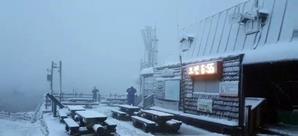
Heavy Snow Pounds South Korea, Alert Issued
This year's Lunar New Year holiday, known as Seol, was extended to six days, lasting until Thursday, after the government designated Monday as a temporary national holiday.
Snowfall of 10 to 20 centimetres is expected in the greater Seoul area, parts of Gyeonggi Province and southern regions of the country to continue through Wednesday, according the Korea Meteorological Administration (KMA)
In some areas, such as Gangwon's inland and mountainous regions, eastern North Jeolla Province and the southern island of Jeju, snowfall could exceed 30 centimetres, according to the KMA.
A snowfall advisory is issued when 5 centimetres or more of snow is expected within a 24-hour period.
More than 100 flights had been delayed at Jeju International Airport as of 6 p.m., with 10 of them canceled due to heavy snow and heavy wind, Yonhap news agency reported.
The Ministry of Interior and Safety said it had activated the Central Disaster and Safety Countermeasure Headquarters.
Acting Interior Minister Ko Ki-dong instructed relevant agencies to mobilise all personnel and equipment to minimize damage from heavy snowfall and implement measures to reduce traffic congestion as millions of people head to their hometowns for one of the country's two major traditional holidays.
In response to the forecast, the Seoul metropolitan government has also raised its alert to the second-highest level.
A total of 9,685 workers have been mobilised, along with 1,424 snow-clearing vehicles and pieces of equipment, to ensure public safety and reduce disruptions.
Lunar New Year is the beginning of a new year based on lunar calendars or, informally but more widely, lunisolar calendars. Typically, both types of calendar begin with a new moon but, whilst a lunar calendar year has a fixed number (usually twelve) lunar months, lunisolar calendars have a variable number of lunar months, resetting the count periodically to resynchronise with the solar year.
The event is celebrated by numerous cultures in various ways at diverse dates. The determination of the first day of a new lunar or lunisolar year varies by culture.

Legal Disclaimer:
MENAFN provides the information “as is” without warranty of any kind. We do not accept any responsibility or liability for the accuracy, content, images, videos, licenses, completeness, legality, or reliability of the information contained in this article. If you have any complaints or copyright issues related to this article, kindly contact the provider above.






















Comments
No comment